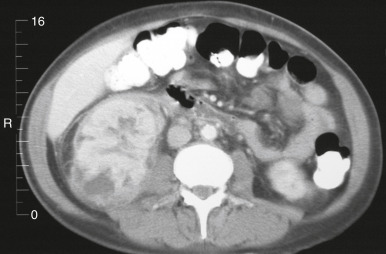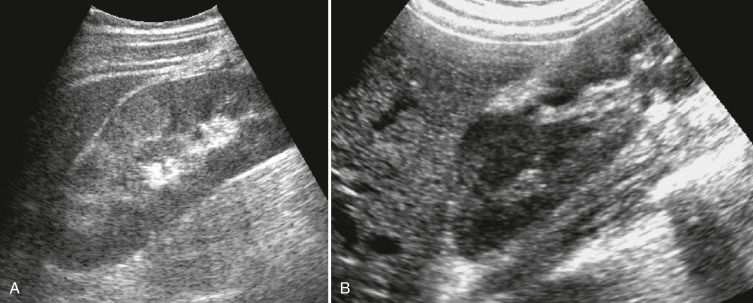AUTHORS: James P. Reichart, MD and Nelson Kopyt, DO
Pyelonephritis is an ascending infection of a bacterial pathogen that infects the renal pelvis and kidney. It primarily presents as a urinary tract infection (UTI) characterized by painful urination (dysuria) with associated flank pain/tenderness, nausea, vomiting, and/or fever. Older adults may also present with failure-to-thrive, unexplained anorexia, other organ system decompensation, or generalized deterioration.
- Uncomplicated: Can be treated as an outpatient with oral (PO) antibiotics.
- Complicated: Inpatient treatment with intravenous (IV) antibiotics is required. Hospitalization is indicated for persistent vomiting, progression of uncomplicated UTI, suspected sepsis, immunosuppression, or urinary tract obstruction. This is a potentially life-threatening infection that can lead to renal parenchymal damage. Timely diagnosis and management can significantly impact patient outcomes.
| ||||||||||||||||||||||||||||||||||||||||
Pyelonephritis is common in the U.S. with overall rates of 15 to 17 cases/10,000 women and 3 to 4 cases/10,000 men. Pyelonephritis accounts for 9.1% to 31% of severe sepsis cases annually, depending on geographic area. Average annual mortality is 16.1%, ranging from 5% for patients <25 yr to 43% for ages >64 yr.
Women are 5 times more likely to be hospitalized than men until the age of 65 yr. In men beyond the age of 65 yr, the difference in prevalence narrows. Risk factors associated with pyelonephritis in healthy women are sexual intercourse (≥3 times wk over the previous 30 days), a new sex partner in the past year, use of spermicide, UTI during the past 12 mo, mother with a history of UTI, diabetes mellitus, and urinary incontinence. Urinary tract obstruction is the most important risk factor for a complicated UTI.
Congenital urologic structural disorders associated with vesicoureteral reflux predispose individuals to infections at an early age (<5 yr) and produce renal scarring in most male and some female patients. Pyelonephritis may produce an Ask-Upmark kidney (segmental renal hypoplasia) that is found more often in young female patients with severe hypertension.
Diagnosis established by clinical presentation, history, and physical examination.
Pyelonephritis is suspected in cases of lower urinary tract symptoms (e.g., urinary frequency, urgency, and dysuria) and frequently accompanied by any of the following:
- Fever, rigors, chills (fever may not be present in older adults or the immunosuppressed)
- Flank pain
- Hematuria: Gross hematuria occurs rarely in acute pyelonephritis and raises suspicion for acute cystitis, papillary necrosis, or lower genitourinary malignancy
- Toxic appearance
- Nausea and vomiting
- Headache
- Diarrhea
Physical examination may elicit costovertebral angle tenderness with flank pain, a nearly universal finding. Its absence suggests an alternative diagnosis. Patients presenting with nephrolithiasis/ureterolithiasis usually do not present with costovertebral angle tenderness. Usually, abdominal or suprapubic tenderness is present.
Ascending infections from intestinal bacteria that colonize the perineum and vulvae in women account for most infections. Less commonly, bacteria, viruses, or fungal pathogens may produce hematogenously induced pyelonephritis.
- Gram-negative bacilli cause >80% of cases (e.g., Escherichia coli and Klebsiella species).
- Less common gram-negative bacteria may produce infection, particularly after urinary tract instrumentation (e.g., Proteus mirabilis, Enterobacter, Serratia, and Pseudomonas species).
- Resistant gram-negative organisms or fungi such as Candida may colonize indwelling catheters.
- Gram-positive organisms such as enterococci and rarely, Staphylococcus saprophyticus.
- Staphylococcus aureus indicates hematogenous spread to the kidneys.
- Viruses generally are limited to the lower urinary tract.
- Urea-splitting organisms generate alkaline urine that fosters production of staghorn calculi. These stones may grow to large size and cause infection, obstruction, or both.
In older adults, E. coli is less common (60%). Patients with diabetes develop infections from Klebsiella species, Enterobacteriaceae, Clostridioides species, or Candida species.
During the past decade, community-acquired bacteria (particularly E. coli) that produce extended-spectrum beta-lactamases have emerged as a cause of acute pyelonephritis worldwide. The most common risk factors for these uropathogens include frequent visits to health care centers, recent use of antimicrobials (e.g., cephalosporins and fluoroquinolones), older age, immunosuppression, recurrent pyelonephritis, nephrolithiasis, and comorbid conditions such as diabetes mellitus and recurrent UTIs.

